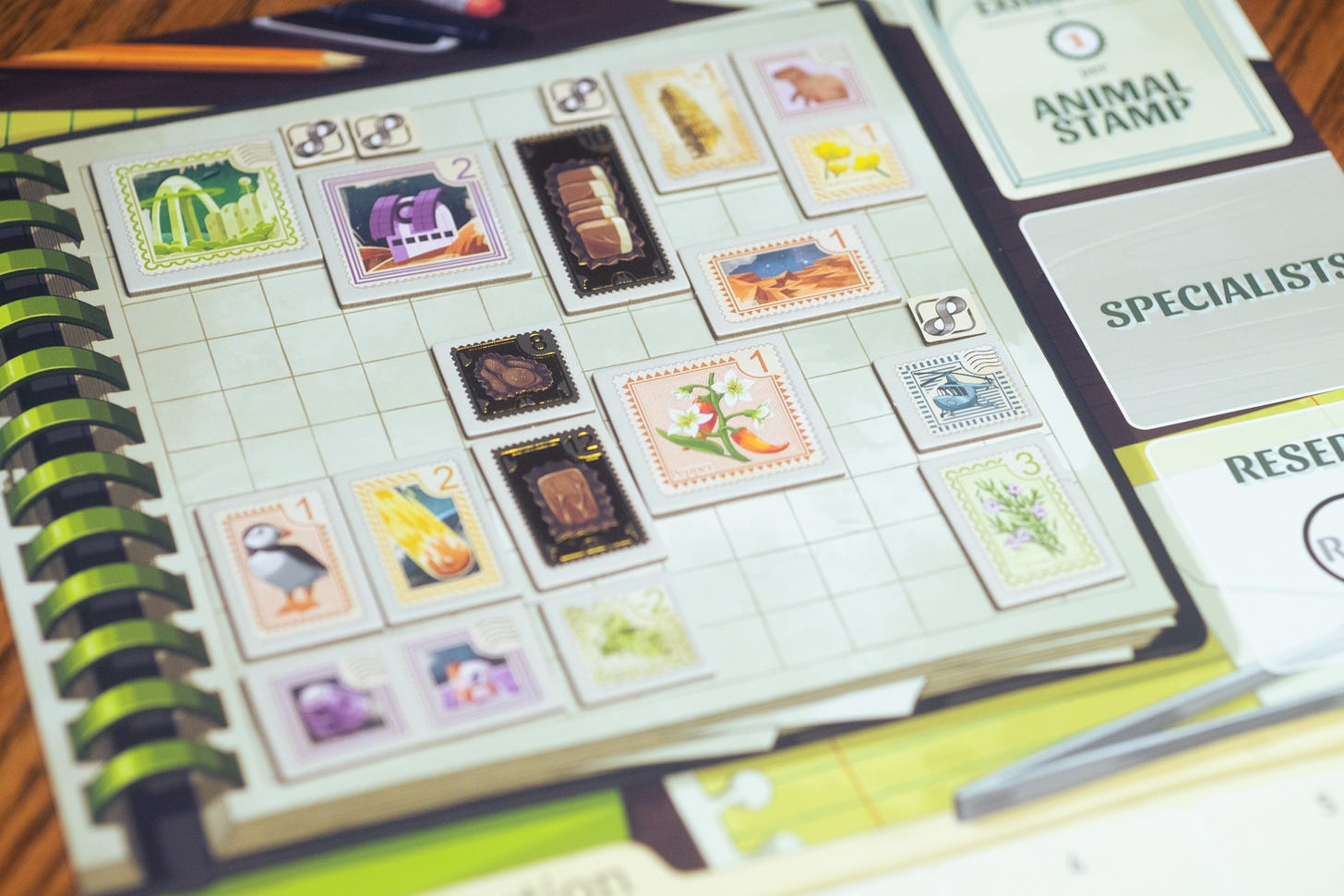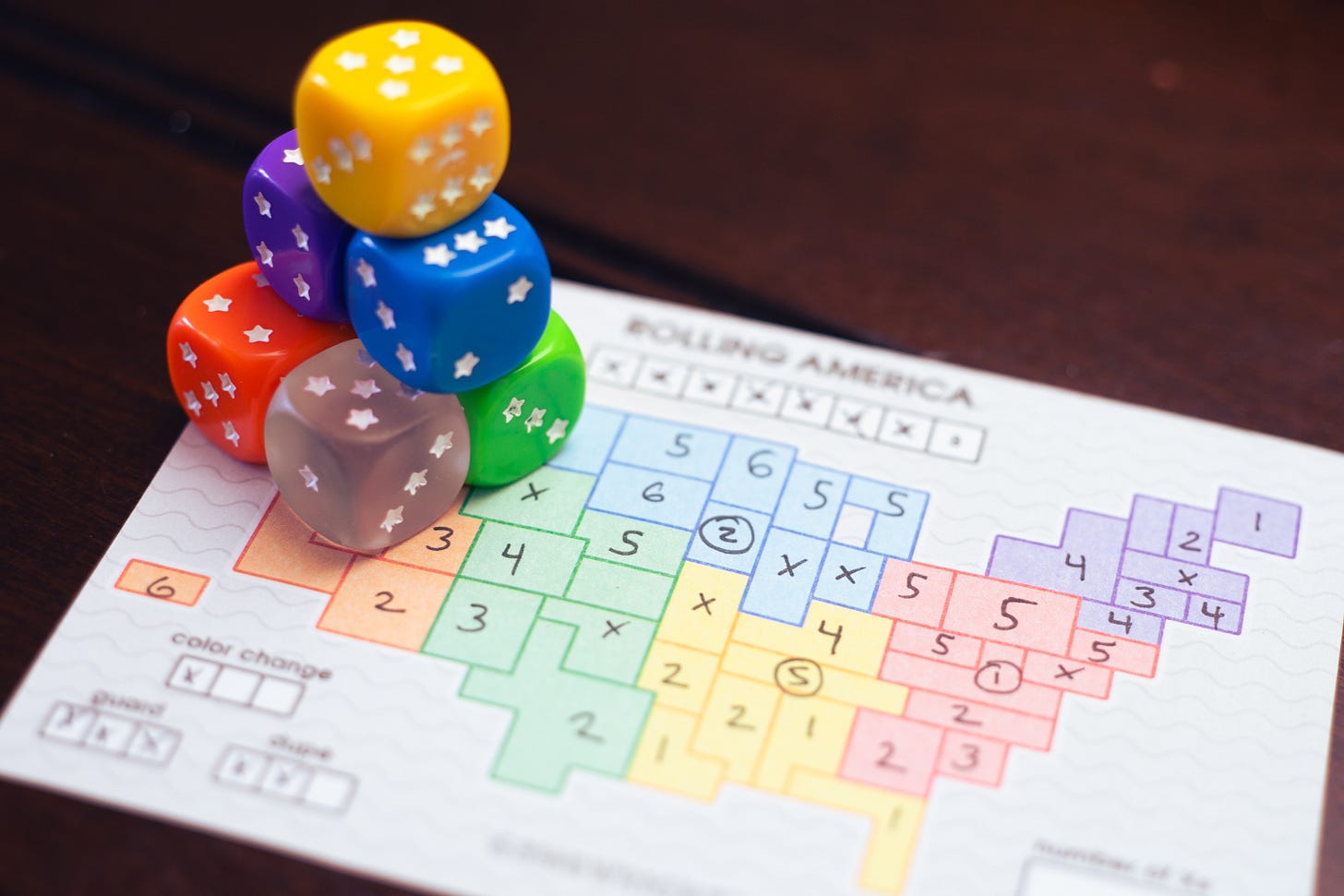What I've been playing lately
Things in Rings, The Ghost Lift and River Valley Glassworks highlight my recent plays.
As promised last week, I’ve got a little bit of a grab bag for you today — we’ve had house guests for a bit, and spending time with them (some of which was spent playing games) means I’m coming at you with a bit of everything this week. We’ll go over some of the games we played, and there are some good ones, if I do say so myself.
Things in Rings is a board game spin on Venn diagrams — isn’t that neat? The Ghost Lift is a ghost-elevator-themed climbing game, and I was certainly delighted throughout. Red Labyrinth was an eerie trick-taking game that hit a little less well, but it still warrants discussion. Rolling America and Cockroach Poker both made an appearance at our visit to Snakes & Lattes in Tempe, Arizona, and Fit to Print featured at home. Throw in one of my favorite lightweight trick-takers, Enemy Anenome, and several games of River Valley Glassworks, and we’re starting to come to a clear picture of the last week of my gaming. There’s a bit more, but we’ll see where we land.
Things in Rings
I know, I know — a Venn diagram-themed board game sounds a bit dry, doesn’t it? You’re probably picturing a poster board with two circles on it, and there are words in those circles. Yawn. You’ve seen these before. But Things in Rings is not that at all. It’s actually sort of exactly what the name says: You’re going to be putting things into Venn diagram rings. One player each game doesn’t get to place (except at the beginning of the game) any cards into rings, but they do act as the Knower, telling people if they’re right or wrong about where they’ve placed.
See, the thing about Things in Rings is that only one player understands what makes up these sections. Each of those sections has a defined type, and you can play with up to three sections (a triple Venn diagram, all the way across the sky, if you will.) They’re labeled as word, attribute and context, and each area will have a rule associated with it. (There’s also an off-board area where things can be played that are not related to any of the rules.) As an example, you might have ‘word’ as “has four letters,” ‘attribute’ as “furry” and context as ‘found in a zoo.”
When you play a word card into an area, the Knower will decide (as truthfully and non-deceptively as possible) if you’ve placed that card in the right area. With the above example, if ‘lion’ was played into the overlapping area of the three sections, the person to have played the card will play again. If it was placed into one section but not the overlapping area, the card would be moved to the correct area, and the player’s turn would end. Perhaps the card played was ‘dog,’ you might move it to the attribute section in this specific case.
Things in Rings is a really cool little party game for small groups. (Does it count if it’s a party if it’s a small group? I think so!) It’s unusual, smart and generally hilarious. We played with my brother and his partner several times, and it got funnier each time we weren’t able to figure out the answers.
Designed by Peter Hayward and published by Allplay. Things in Rings plays 3 to 6 players, and there’s a two-player variant as well.
The Ghost Lift
I love climbing games, especially as a subset of the broad trick-taking set of games. (Venn diagram time? Hmm. Maybe not.) I think it’s interesting to figure out when you should play great cards, when you should play your worse cards, and what combinations you can make to freeze out your opponents. The Ghost Lift is a simple climbing game in most aspects: On your turn, you’ll play one or more cards of the same value, and you’ll play it according to whatever direction was most played.
Given it’s elevator-themed, that direction swaps back and forth throughout a round. When the game starts, you’ll play up or down depending on a card flipped over from the deck; 1 through 5 proceed upward, and 6 through 10 proceed downward. Some cards also instruct you on the direction you’ll be placing — maybe you’ll get the dreaded 9 card with up arrows, indicating you have to play a 10. The rules are quick and easy, and play (once you get past getting the rules wrong the first time — sorry, Whitney and Jeffrey!) is just ever so slightly tense. It’s a casual climber with a cute ghost theme. What’s not to love?
Scoring gets a little weird, but it’s not hard: Once one player has run out of cards in their hand, players will record the ranks of their remaining cards (just once for each rank — multiples won’t hurt worse), marking a number first with a slash in one direction, then on a second occurrence, a slash in the other direction, creating an X. The first player to have three Xs on their board loses. (Ah, one-loser games. We’ll come back to you.)
Designed and published by Ridge Gear. The Ghost Lift plays 3 to 6 players.
More games with one loser
The Red Labyrinth is a trick-taking game in which you’re trying to avoid encountering an entity (and it’s a creepy one, at that). That entity is at the end of your hand, and every time you pass instead of playing to a trick, you’ll move that entity closer to the left side of your hand. When you pass play, you’ll get to play a card from left of the entity into a ‘memory archive,’ but you can never place a card from the right of the entity face-down. That would be great on its own, but I do think the game adds a little too much — every time you play a card to a trick, you’ll execute a bonus on the card you’ve played. That makes the game a bit too chaotic, really, as an action takes place after every card played to a trick. It almost makes me want to pass, even if it means encountering the entity.
I might try restricting when you get to play a bonus or something, because I do think there’s a very cool game in here somewhere. At the end, only one player loses, and that’s by virtue of not being able to pass in two separate rounds. This gets just a bit too long as a result, too, unless one player is doing considerably better than the others. Designed by Beomhee Kim, published by SEOWOL BoardGames. The Red Labyrinth plays 3 to 5 players.
Cockroach Poker is an absolute classic bluffing game. It’s simple: On your turn, you’ll hand somebody a card from your hand, and you’ll tell them what type of creature is on the card, or you’ll lie about what’s on the card. There are eight different creature types. If the player to whom you’ve handed the card thinks you’re lying, they’ll indicate that. If they’re correct, and you were lying, you have to take the card. If they’re incorrect, and you’re telling the truth, they have to take the card. The first player to gain four of the same type of creature will lose the game. If that’s not simple enough, this embedded clip from the anime After School Dice Club will probably do a better job. (Seriously, this show is great, and I think you should watch it.) Designed by Jacques Zeimet, published by Devir (among others.) Cockroach Poker plays between 2 and 6 players.
More games we played
Stamp Swap is an I-split-you-choose game in which you’re collecting stamps and competing in stamp-collecting shows. That theme sounds mundane, but the game isn’t — it’s colorful and bright, and it’ll force you to strike a compromise with yourself. I’ll be talking about this one more soon, because I really think it’s got something special about it. Designed by Paul Salomon, published by Stonemaier Games.
Rolling America is a nice little roll-and-write game that makes me upset with myself. In this one, you’re rolling two dice at a time and writing numbers on states in a map of the United States. When you write a number, you’re restricting the numbers that can be on neighboring states, so you’ll want to be extra careful. And here’s the problem, of course: I’m not very good at being extra careful. Designed by Hisashi Hayashi, published by Gamewright. Rolling America accomodates any number of players.
Fit to Print is still my favorite journalism-themed board game — it hits the marks of working on a printed newspaper so well. You’re picking up tiles in one phase, then placing them in another, and the two phases combined are timed. It’s fast-paced, hectic, and just so beautifully illustrated and themed. I haven’t talked about the game itself in much depth, though I did interview the designer, Peter McPherson, just over a year ago in Theme, mechanics and Fit to Print. (I should talk about it more — maybe in a look at Flatout Games? Hmm!) Designed by Peter McPherson, published by Flatout Games. Fit to Print plays 2 to 6 players and has a solo variant.
Enemy Anenome is such a great little trick-taking game. It’s one of those must-not-follow games, but it has one major twist: The player who plays the lowest card each in each trick gets an anenome card, and on future turns, anenome cards can be used to bolster the rank of a card you play to a trick. If you can’t play a card, you’ll discard one into your scoring pile. Neat stuff! I wrote about this one more earlier this year inSix more great trick-taking games, if you’re interested in exploring it more. Designed by Daniel Newman, published by New Mill Industries. Enemy Anenome plays 2 to 6 players.
River Valley Glassworks is adorable, smart and puzzly: What’s not to love? This is a game in which you’re collecting glass of varying rarity, and you’ll place that glass in a grid, with each color of glass occupying only one column of your choosing. The higher you get those columns, the more points you’ll end with. Read about it quite a bit more in Wyrmspan, River Valley Glassworks and Nocturne: Three great 2024 board games. Designed by Adam Hill, Ben Pinchback, and Matt Riddle; published by Allplay. River Valley Glassworks plays 2 to 5 players nas has a solitaire variant.
Well, it’s late, and I’ve got work to do in the morning. I’m again not sure what I’ll be focusing on next week, so let’s just see what rolls in. Thanks again for reading — without you, I wouldn’t be writing this newsletter every week.








We loved playing all these games with you! And the rule change of Ghost Lift made it a very fun few rounds before we played the actual game!